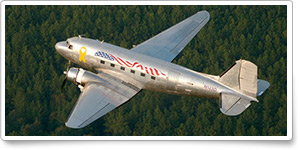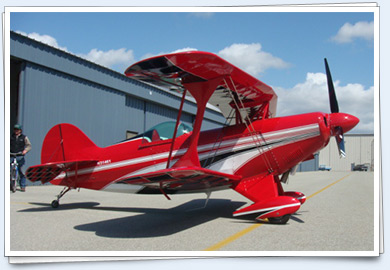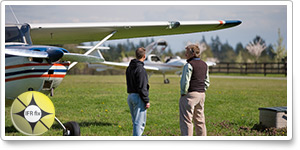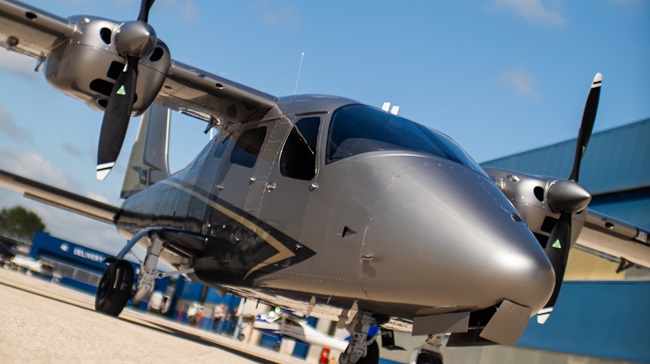| ||||||
| ‘After Landing’ |
| |||||
Training Tips‘After landing’ The next aircraft is on a touch and go—and it’s a dramatic arrival to behold. The airplane seems to float, before touching down loudly in a flat attitude. On the “go,” it abruptly balloons upward, seeming to hang above the runway at low airspeed. From the ramp, onlookers see that the pilot has failed to “clean up” the airplane which, still in the landing configuration with full flaps extended, is having a hard time climbing away. Fortunately, a flight instructor is aboard, and now the wallowing trainer’s pitch lowers slightly. The flaps can be seen gradually retracting until the climb resumes at a strong, positive rate. The difference in the quality in the arrival of the two trainers had a simple but vital cause: One pilot performed the prescribed after-landing checklist. The other pilot neglected to run the short list. How short? For a 1980 Cessna 152, the after-landing checklist consists of two items: “wing flaps—up” and “carburetor heat—cold.” The Cessna 172RG Cutlass, a complex aircraft, has a third item: " cowl flaps—open." Don't get the idea that only a pilot a flying touch and go is vulnerable to the problems described here. On the ramp it's not uncommon to behold an aircraft taxi in and shut down—the pilot walking away with the aircraft's flaps still conspicuously full down. If that aircraft also was taxied in with the carb heat not set to "cold," the aircraft was ingesting unfiltered air—and any jagged debris it contained—into the engine as it rolled along. So, what causes the lapse? Distraction, usually. On a touch and go, pilot tension or tricky winds can give a pilot all he can handle before the aircraft leaves the ground again (although it usually takes just one incorrectly configured takeoff to serve as a rude and lasting reminder). On a full-stop landing, letting down mentally after a tough approach, or preoccupation with finding one's way around an unfamiliar airport, have caused similar lapses. But a checklist doesn't have to be long to be important. After every touchdown, run the list. Flight Training NewsFAA creates online Class B graphicsThe FAA is rolling out online Class B enhancement graphics for all Class B areas in the nation. The graphics enable pilots to see key details and useful reference points while removing the clutter of underlying topographic features. Read more >> Brazilian company gets Redbird simulatorsRedbird flight simulators are migrating south after a Brazilian company bought multiple simulators during the Sun ’n Fun airshow and fly-in. Instituto Arruda Botelho purchased simulators for the Cessna Caravan, King Air 90C, and Piper Matrix. Read more >> Aircraft Electronics Association awards $100,000 in scholarshipsAt its annual meeting last week, the Aircraft Electronics Association (AEA) awarded more than $100,000 in scholarships through the AEA Educational Foundation. Scholarships for the 2012-2013 academic year were awarded to 25 students. The foundation awards scholarships to students who are pursuing careers in the general aviation maintenance and aircraft electronics industry. Applications for 2013-2014 can be made after Oct. 1 and may be made online. The deadline for returning applications is Feb. 15, 2013. K-State helicopter program shows growthA partnership with Universal Helicopters has proven beneficial for the flight program at Kansas State University at Salina, the college said April 3. The program, which began in January, now has an enrollment of 20 students. They are flying in two Robinson R22 Beta IIs and an R44 Raven II. “The growth far exceeds my expectations,” said aviation department head Kurt Barnhart. “We have already achieved what I anticipated would take six months to a year.” ‘Up here, wishing I was down there’How do you handle an emergency? Practice, planning, and good judgment can improve the odds tremendously, but despite our best intentions, sometimes things just go wrong. In the Air Safety Institute’s Emergency Procedures Safety Advisor you’ll get advice on what is an abnormal situation versus a full-blown emergency, and ways to handle critical situations as safely as possible. You’ll learn how to troubleshoot and tackle emergencies and how to be well prepared for survival. Download the guide now >> Training ResourcesAt best, radio skills let other pilots and ATC know where you are and what you are doing. At worst, they can play a significant role in causing an accident. Proper communication is a necessary skill for pilots. Build confidence as you improve your radio skills with the Air Safety Institute’s online course Say It Right: Mastering Radio Communication , underwritten by Lightspeed Aviation.
Did you know that student pilots who join AOPA are three times more likely to complete their flight training? Membership includes unlimited access to aviation information by phone (800/USA-AOPA, weekdays from 8:30 a.m. to 6 p.m. Eastern time) or from Flight Training Online or AOPA Online. If you’re not already a member, join today and get the pilot’s edge. Login information is available online. Youngest B-29 pilot Career PilotPinnacle files for Chapter 11Pinnacle Airlines Corp. and its subsidiaries announced April 1 that they have filed voluntary bankruptcy petitions under Chapter 11 of the United States Bankruptcy Code. Pinnacle, which operates flights for Delta Connection, United Express, and US Airways Express, said it intends to continue implementing a comprehensive turnaround plan aimed at addressing operational and financial challenges in a rapidly evolving regional airline industry. During the reorganization Pinnacle plans to restructure its key operating agreements with Delta Air Lines, wind down its operations with United Airlines, conclude its essential air service flying for US Airways, and achieve cost savings from its workforce and across the organization. Pinnacle also said its Colgan subsidiary will be ending the operation of its remaining Saab 340 and Q400 aircraft. US Airways launches new service to 14 cities from ReaganUS Airways began new service to 11 communities—and increased frequencies to three others—from Washington, D.C.’s Reagan National Airport on March 25. The airline launched nonstop flights to Birmingham, Ala.; Fayetteville, N.C.; Islip, N.Y.; Little Rock, Ark.; Jacksonville, N.C.; Memphis, Tenn.; Omaha, Neb.; Ottawa, Ontario; and Pensacola, Tallahassee, and Fort Walton Beach, Fla. Additional flights are being added to Savannah, Ga.; Bangor, Maine, and Hartford, Conn. In addition, US Airways announced March 21 that it would begin service from Reagan National June 8 to San Diego, and July 11 to Augusta, Ga.; Minneapolis; Fayetteville, Ark.; Montreal, Quebec; and Toronto, Ontario. The new flights are a part of the airline's plan to focus on its core service areas of Washington, D.C.; Philadelphia; Phoenix; and Charlotte, N.C. Plane SpotterDC-3: Revolutionary transport Training ProductsBrightline Bags debuts Flex SystemBrightline Bags, makers of flight bags known for multiple compartments with color-coded zip pulls, has unveiled a new catalogue of products known as the Flex System. The system enables pilots to purchase preconfigured bags ranging in price from $109 for the B2 Compute to $254 for the B25 Carryall. Or, you can put together your own system from an assortment of bags, caps, center sections, and pockets. These range in price from $89 for a front bag to $15 for a side pocket. See a video on the system. Order online or call 415/721-7825.
Note: Products listed have not been evaluated by ePilot editors unless otherwise noted. AOPA assumes no responsibility for products or services listed or for claims or actions by manufacturers or vendors. Member BenefitsAOPA wallet is an easy way to comply with FAA regsFAR 61.3 mandates that a pilot carry a form of photo ID when flying. AOPA has made compliance easy with the AOPA ID wallet, which features an insert to hold your driver’s license, your pilot certificate, and your medical. These documents fit into a three-pocket insert with a convenient side-entry pocket that can be removed from the wallet so that your critical documents are with you in the airplane. When you’re finished flying, simply put the insert back in your wallet. The black leather wallet measures 3.5 inches by 4.75 inches when folded and features the AOPA wings logo embossed on the inside, eight slots for credit cards, and a divided bill compartment. This wallet is available at the AOPA Store for $36.95. Visit the store for further details and additional AOPA items. Don’t need a new wallet? You can buy the Ramp Pass ID holder separately, also in black leather, for $14.95. Term life insurance options from AOPANo one insurance program is best for all of AOPA’s members. That’s why AOPA offers three options when it comes to securing term life insurance to provide for your family’s needs if something should happen to you. AOPA offers a group term life insurance plan, a level term life insurance plan, and PilotLife Plus for members over the age of 50 and under the age of 75. Read more >> BlogsTruly rare eventsIn airline flying, missed approaches and go-arounds are not that common. But a crew still needs to prepare, as Chip Wright explains in the Flight Training blog. After the forced landingOn her way home from EAA AirVenture 2011, Arty Trost had an off-airport landing in her Maxair Drifter. An unscheduled stop in a Wyoming wheat field was just the start of her challenges. Read more in the Let’s Go Flying blog. AOPA Career OpportunitiesEver dream of turning your passion for aviation into a career? We’re looking for a vice president–Center to Advance the Pilot Community, aviation technical writer, vice president of strategy and philanthropic operations, director of accounting, program manager–products, project manager of online products, director of new market development, associate project manager, and associate editor–Web/ ePilot. To learn more about other AOPA career opportunities, visit AOPA Online. Community
AVIATION EVENTS & WEATHER
| ||||||||||||||||||||||||||||||||||||




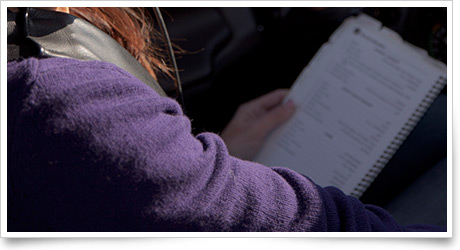 The student pilot makes a nice
The student pilot makes a nice 
